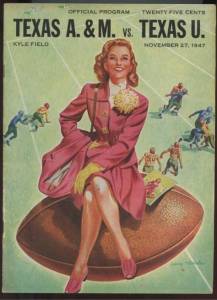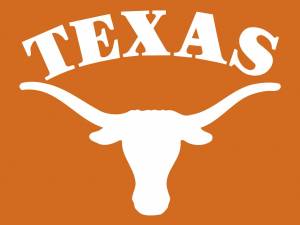As I have said before in various ways, I am ambivalent about my alma mater. I attended and graduated from the University of Texas and spent about 30 years in Austin, but it is not the central fact of my life. While UT is a big school (more than 500,000 living alumni) and a good one (No. 63 in the QS World  University Rankings), there are other institutions of higher learning. In the realm of collegiate sports and rivalries, however, we Longhorns appear to have some special status in the eyes of our foes.
University Rankings), there are other institutions of higher learning. In the realm of collegiate sports and rivalries, however, we Longhorns appear to have some special status in the eyes of our foes.
I will begin with Texas A&M and its students and alums. Until 1962 when Darrell Royal unilaterally replaced bright orange with dark “burnt” orange, they called us “yellow bellies.” It’s a rather weak put-down which a few old-timers still use. I can remember my father (1927-2005), an inveterate UT hater, saying it as well.
More prevalent is the Aggies’ reference to the University of Texas as “texas university” or “tu”—lower case and no periods. [Let me interrupt myself and assert that our insistence on capitalizing the article “the” {“The University of Texas”} just welcomes ridicule. It is pretentious and pompous, and makes us look self-obsessed. I have never adhered to this quirk and once told the editor of the alumni magazine Alcalde that it should be done away with.] I sometimes encounter an A&M student or alumnus who tries this on me, leading to a swift and direct response. I urge these men to grow up and abjure their juvenile ways. I remind them that both are good schools (although A&M’s current QS ranking is 195, far behind that of “tu”), that we have a long and shared history, and that demonstrating respect and good sportsmanship is not a sign of weakness. These contretemps have happened too many times.
who tries this on me, leading to a swift and direct response. I urge these men to grow up and abjure their juvenile ways. I remind them that both are good schools (although A&M’s current QS ranking is 195, far behind that of “tu”), that we have a long and shared history, and that demonstrating respect and good sportsmanship is not a sign of weakness. These contretemps have happened too many times.
Let us turn our attention to the “Hook ’em, Horns” hand sign, first used by Texas cheerleaders and fans at the 1955 TCU game. It is not the only such sign; schools like Oregon State, Southern Cal, Miami, Wisconsin, Vanderbilt, Florida, Texas Tech, Ohio State, Hawaii, Baylor and  Arizona State have their own. I would not be surprised if Southwest Mississippi Junior College has one, too. None, however, comes close to the fame and iconic status of UT’s “Hook ’em, Horns.” I have attended lots of UT football, basketball and baseball games, the Texas Relays and even a women’s volleyball game at Gregory Gym, and I have not employed the “Hook ’em, Horns” since my undergraduate days. I am in the minority, though; just about all Texas students, alums and fans do it.
Arizona State have their own. I would not be surprised if Southwest Mississippi Junior College has one, too. None, however, comes close to the fame and iconic status of UT’s “Hook ’em, Horns.” I have attended lots of UT football, basketball and baseball games, the Texas Relays and even a women’s volleyball game at Gregory Gym, and I have not employed the “Hook ’em, Horns” since my undergraduate days. I am in the minority, though; just about all Texas students, alums and fans do it.
A reaction set in not long after that game against the Horned Frogs. The Daily Texan in 1963 showed a Baylor fan subverting the sign, something that has come to be called “Horns down.” Five years later, Jerry LeVias  and Chuck Hixson were seen doing it before SMU’s game with the Horns. But it seemed to pick up momentum when Barry Switzer started coaching at Oklahoma. His players did it on the field, and OU fans did it in the stands—especially when a camera was trained on them. This is only my impression, and please remember that I have been in Korea now for nearly 12 years and cannot pretend to have a good feel for contemporary college sport. The “Horns down” thing peaks with the UT-OU game in the Cotton Bowl every October, but we now see it from virtually every Texas opponent.
and Chuck Hixson were seen doing it before SMU’s game with the Horns. But it seemed to pick up momentum when Barry Switzer started coaching at Oklahoma. His players did it on the field, and OU fans did it in the stands—especially when a camera was trained on them. This is only my impression, and please remember that I have been in Korea now for nearly 12 years and cannot pretend to have a good feel for contemporary college sport. The “Horns down” thing peaks with the UT-OU game in the Cotton Bowl every October, but we now see it from virtually every Texas opponent.
 In 2012, Mack Brown—now there’s a coach who stayed too long—whined about opposing players doing the “Horns down” sign. He said the Big 12 should outlaw it, penalize players who do it and maybe even make them go stand in the corner. This, of course, had a predictable effect as the number of opponents doing the “Horns down” sign ballooned. Students and fans of other schools now do the “Horns down” sign as they walk into the stadium. They buy UT decals and put them on their cars, upside down.
In 2012, Mack Brown—now there’s a coach who stayed too long—whined about opposing players doing the “Horns down” sign. He said the Big 12 should outlaw it, penalize players who do it and maybe even make them go stand in the corner. This, of course, had a predictable effect as the number of opponents doing the “Horns down” sign ballooned. Students and fans of other schools now do the “Horns down” sign as they walk into the stadium. They buy UT decals and put them on their cars, upside down.
 I admit, I get somewhat vexed when Aggies call my school “tu.” But when Bears, Mustangs, Sooners and others try to mock Bevo, I feel as unruffled as Buddha sitting under the banyan tree. If I could be roused from my deep tranquility, I would say: “Go right ahead, fellas. It’s true that we are a college football behemoth, having won 891 games entering the 2019 season and four national championships. UT is just about everybody’s No. 1 rival. A victory over the Longhorns means a lot to you. We realize we are important, but are we so important that you define yourselves in terms of us?”
I admit, I get somewhat vexed when Aggies call my school “tu.” But when Bears, Mustangs, Sooners and others try to mock Bevo, I feel as unruffled as Buddha sitting under the banyan tree. If I could be roused from my deep tranquility, I would say: “Go right ahead, fellas. It’s true that we are a college football behemoth, having won 891 games entering the 2019 season and four national championships. UT is just about everybody’s No. 1 rival. A victory over the Longhorns means a lot to you. We realize we are important, but are we so important that you define yourselves in terms of us?”


6 Comments
Richard
The rivalry off the field of play where fans seek to un-nerve their opponents by quirky and trite mannerisms and sayings is germaine to all interactions of people groups. Call if “one-up-manship” if you will. Wouldn’t you agree, it is associated with the psychology of winning. We abbreviate it as “psyching each other out. The playful barbs, cuts and jabs. Yes, you are right Richard, it can get carried away. We need to love our neighbor as ourselves, right? Be kind to one another. You reap what you sow. Forgive and forget. All good morals for interacting with one another.
Gary–I am all in favor of vigorous, even fierce athletic competition. But I think it’s equally important to do so within the context of respect and good sportsmanship. Oh, these silly put-downs!! So juvenile…
Richard:
I loved your essay. It reminds me of Terrell Pryor when he was introduced at a
Ohio state press conference upon signing, he said, ‘Thanks. I always dreamed of going to the University of Ohio State.”
Best,
Rex
Ha!!
I still follow UT athletics since I have lived in Austin for 60 years. Other than that, I am not a fan of the school. Liberal indoctrination is the biggest by product of the school. I also feel that while getting a degree from an ivy league school or big school may open the door for the first job, 15 minutes after you are there they will never look at your transcript again. It is just one factor of many that will affect your career success.
Kenny, I agree with both of your points. Number one–I thought they force-fed us the left-wing stuff when I was a student, but apparently it is even worse now. And number two–whether Harvard or Southwest Texas State, you have to be able to do the work.
Add Comment